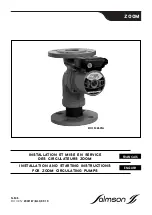
5
Whenever possible, install your Battery
Back-up System with a direct discharge
to the outdoors. By using this method,
there will always be an outlet for the
water from the sump. During times of
very heavy rain, many storm sewers fi ll
up. If your pump is trying to discharge
water into a full sewer, there is nowhere
for the water to go. This defeats the
purpose of the back-up system. By
discharging directly outdoors, there is
always an outlet for the water that is
pumped out of the sump.
There are two options for installing your
sump pump with a direct discharge to
the outside. If you have a sump pit wide
enough to place the backup pump next
to the main pump, use Method A. If your
sump pit is too narrow, the pump may
be mounted above the main pump. In
this instance use the instructions for
Method Aa.
METHOD A:
DIRECT DISCHARGE TO THE
OUTSIDE OF THE BUILDING
FOR WIDE SUMP PITS
(Diagram A)
1. Cut a four foot (4’) piece of 1-1/4”
rigid PVC pipe and cement it to the
threaded
fi tting that is attached to
the elbow on the pump.
2. Secure the pump wire so that the
plug on the end will not fall into the
sump. Attach the wire to the pipe
with a piece of tape.
3. Place the pump with the 4’ PVC pipe
attachment on the bottom of the
sump
fl oor next to the main AC pump.
Do not mount the pump to any
existing
pipes.
It should be placed
on
the
fl oor of the sump. A brick may
be placed under the pump if there
are rocks or other debris on the
sump
fl oor.
4. Attach a rubber union (not included)
to the top of the 1-1/4” pipe. This will
allow the pump to be removed
easily, should the need arise.
The path of the rest of the pipe and
the details of each installation will vary.
Using sound plumbing practices, try to
route the discharge pipe to an exterior
wall via the shortest path with the
fewest turns. The pipe section exiting
the building should be on a downward
slope so that the water in the pipe
will exit outside rather than return to
the sump. Extend the discharge pipe
outside the building as far as possible
to avoid the return of discharged water
to the sump.
Be sure to seal the hole in the wall
where the pipe exits and cement or
clamp all connections securely to
prevent leaking. No check valve is
needed with this method of installation,
as long as you use
less than 20 feet
of pipe.
Diagram A
Содержание BARNES BUS Series
Страница 13: ...Notes ...
Страница 14: ...Notes ...


































